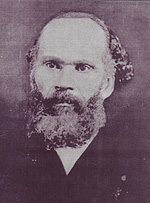Abraham D. Shadd

Abraham Doras Shadd (March 2, 1801 – February 11, 1882) was an
Early life
Abraham Shadd was born on March 2, 1801, to Jeremiah Schad and Amelia Siscoe. Jeremiah Schad was a son of Hans Schad, alias John Shadd, a native of
Personal life
Shadd married Harriet Parnell in the early 1820s and together in 1823 had their first of thirteen children, Mary Ann Shadd.[6] She and her siblings would be raised Catholic.
Civil rights and abolitionist movements
By the 1830s, Abraham Shadd started to become more prominent in the abolitionist movement. He used both his homes in West Chester, Pennsylvania, and Wilmington, Delaware, to provide lodging for fugitive slaves fleeing southern states.[5] He was a prominent voice in the anti-colonization movement.[6] Shadd was one of five black men at the founding of the Board of Managers of the American Anti-Slavery Society in 1833, as well as a prominent member of the Colored Conventions Movement, serving as a leading delegate in both the 1841 and 1848 black national conventions, both held in Philadelphia.[5]
Life in Canada
While being a vocal critic of black colonization for most of his life, Abraham Shadd was prompted to move his family north to Canada West (Ontario, Canada) with the passing of the Fugitive Slave Act of 1850. Less than a decade later he would become one of the first black elected officials in Canada, being elected in 1859 to a seat on the Raleigh Township Council.[5] Shadd became a very prominent member of his new Canadian community, creating a school within the Raleigh Township, as well as creating a loan system with his farm tools and equipment, in order to assist other farmers in the community.[8] He also was a member and early trustee of the Prince Hall Masonic Lodge, which assisted former black slaves and freed men in their immigration to Canada West.[8][9]
Death
Shadd died on February 11, 1882, a very prominent and well-known man within Canada West and the abolitionist and civil rights movements of the 1800s. His prominence fostered a large funeral ceremony attended at Maple Leaf Cemetery by residents of Kent County, where he would be buried.[8]
Legacy
In February 2009, Shadd was commemorated with a stamp by Canada Post.[10]
References
- ISBN 9781317454168.
- ISBN 9781851097746.
- ^ "Shadd, Abraham Doras (1801-1882) | The Black Past: Remembered and Reclaimed". blackpast.org. 24 February 2009. Retrieved November 26, 2018.
- ^ Scott, P. (July 1, 2010). "Abraham Doras Shadd". The Mill Creek Hundred History Blog. Retrieved May 1, 2019.
- ^ )
- ^ a b c Rhodes, Jane (1998). Mary Anne Shadd Cary: The Black Press and Protest in the Nineteenth Century. Bloomington, Indiana: Indiana University Press. p. 4.
- ^ Rhodes (1998). Mary Anne Shadd Cary: The Black Press and Protest in the Nineteenth Century. p. 79.
- ^ a b c "Shadd, Abraham D. (1801–1892)". Municipality of Chatham-Kent. 20 November 2017. Archived from the original on 19 December 2018. Retrieved November 28, 2018.
- OCLC 85622776.
- ^ "Abraham Doras Shadd & Rosemary Brown". Canada Post. February 2, 2009. Retrieved February 9, 2019.
External links
- Chatham-Kent. Shadd, Abraham D. (1801–1882) Archived 2018-12-19 at the Wayback Machine. Chatham-kent.ca. Retrieved November 28, 2018.
- Ito, Gail Arlene. "Shadd, Abraham Doras (1801–1882)". Blackpast.org. Retrieved November 16, 2018.
- African American Registry. "Abraham Shadd, Abolitionist Born". Aaregistry.com. Retrieved November 16, 2018.
